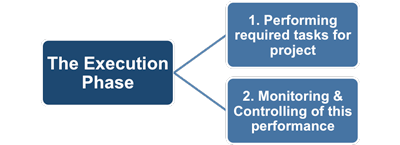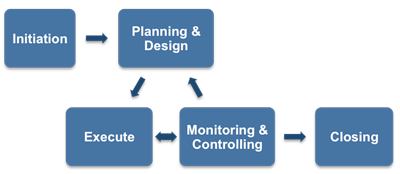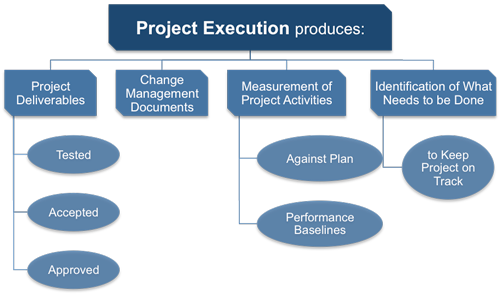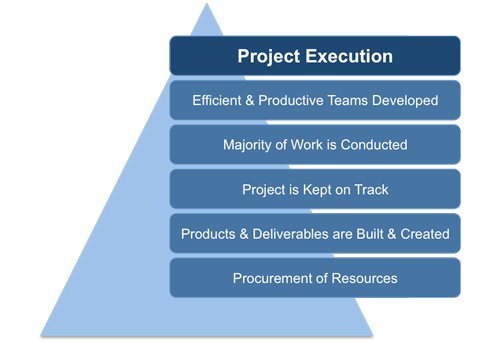Project Executing Processes
The whole point of a project is to produce deliverables of some sort and the execution phase is where this happens. Essentially, work is done according to the project plan and that work is monitored and the results fed back to the people responsible for the plan so that it can be updated to reflect the progress made.
 |
It is possible to see this phase of the project as consisting of two processes: the 'doing' or executing, and the monitoring and controlling.
 |
This phase is often called 'Execution and Control' because it does not represent a blind implementation of the initial project plan but rather a cyclical process. As you can see from the diagram above, the planning, executing, and the monitoring and controlling processes are all interdependent.
Executing consists of the processes used to complete the work defined in the project plan to accomplish the project's requirements. Execution process involves coordinating people and resources, as well as integrating and performing the activities of the project in accordance with the project plan. The main output of project execution is the project deliverables and producing these will be the responsibility of the project team who will be working to the project plan.
The actions performed during this process include:
1) Performing the activities needed to meet the project objectives
2) Obtaining and manage quotations, bids and proposals as needed
3) Managing the project team and manage other resources
4) Collecting and analyze performance data
5) Generating project data for status reports and forecasts
6) Managing risks
7) Conducting change control and implementing approved changes
8) Establishing and managing project communication channels
9) Collecting and documenting lessons learned
Monitoring and controlling consists of monitoring project execution so that potential problems can be identified in a timely manner and corrective action taken as necessary. Monitoring and controlling includes measuring the ongoing project activities and the project variables (cost, effort, scope, etc.) against the project plan and the project performance baseline. It then identifies what needs to be done in order to get the project back on track.
Over the course of any project, the scope may change either as the result of necessary design modifications, differing site conditions, material availability, contractor-requested changes, value engineering and impacts from third parties, to name a few.
 |
The change normally needs to be documented to show what was actually done; this is referred to as change management.
No matter how carefully planned a project has been, changes will need to be made as it progresses. These will result from both external influences as well as problems that arise within the project environment. The four main sources of change are:
Organizational: High level business decisions may change the basic terms of reference of the project - for example there may be a change to the overall scope of the project.
Environmental: resulting from changes in legislation or changes in government policy or changes in business strategy.
Technical: New technology may offer a better solution to that originally planned. Alternatively, technical problems may prevent a product from working in the way that it was supposed to.
End-User: resulting from changes in customer requirements. It is also possible that feedback gained during the review or testing of a product may show that it is unsuitable in some unexpected way.
Any person associated with a project should be able to raise any concern they have at any time. The concern may involve a perceived problem or a suggestion for an improvement to some area of the work, documentation or project organization. These issues should be reviewed at regular meetings. There are three possible outcomes when an issue is considered:
A change to the design or features of a product may be agreed. This will mean changing the way the product is specified in the plans and updating any costs and timescales accordingly. An impact analysis should also be performed. This process looks at the knock-on effects of the change on other deliverables, and also the effect if the changes are not implemented. The purpose of the impact analysis is to arrive at a balanced view of the effect of the proposed change on the projects ability to satisfy its mandate. This will enable project management to decide whether to proceed with the change or not.
The proposed change is rejected because it is not felt to represent a significant concern.
The third option is unusual but it does occasionally happen that a deliverable does not agree with its specification but changing the specification is a better solution than changing the deliverable.
Where changing the deliverable is thought to be the best option, the project manager should use the impact analysis to assess the change in terms of its effect on timescales, cost, benefit, quality, personnel and risk and to decide at what level the decision to proceed should be taken. He or she should then determine whether or not the proposed change is significant enough to be referred back to the sponsor.
Managing the Project Team
At the very beginning of the project, the process of acquiring a project team is concerned with confirming human resource availability and obtaining the personnel needed to complete project assignments. Acquiring the project team is often complicated by the fact that the project manager will not usually have direct control over everyone they would like to have involved in the project. They may need to negotiate with others who are in a position to provide the right number of individuals with the appropriate level of knowledge skills and experience.
The next objective is to build a team that can work well together. This process should be started early on in the project because team building takes time and a team that works well together will have a major influence on project success. Team performance can be developed by using open and effective communication, developing trust among team members, managing conflicts in a constructive manner, and encouraging collaborative problem-solving and decision-making. Team building is an important complex topic and an aspiring project manager should take the time to study other material on this subject. For example: Productivity Skills, Leadership Skills, Appraisal Skills and Meeting Skills.
Once the project work begins then the project manager will need to focus on tracking team member performance, providing feedback, resolving issues, and managing changes to optimize project performance. Managing people is probably one of the most complex areas as they can be unpredictable, can come into unexpected conflict with one another, their level of their morale can go up or down, and some may even decide to leave the project before it is completed.
Directing and Managing the Project Work
This involves leading and performing the work defined in the project plan and implementing approved changes to achieve the project's objectives. The main inputs to this process are the project management plan (described in detail in the previous section) and approved change requests.
Managing Project Quality Assurance
There is a lot of confusion about quality assurance and quality control. The difference is that quality assurance is part of the executing process and is concerned with making sure that the quality objectives are met. It is focused on process improvement. This process also provides an umbrella for continuous process improvement, which is an iterative means for improving the quality of all processes so as to reduce waste and eliminate activities that do not add value.
Managing Communication with Project Stakeholders
The purpose of this process is to keep the various stakeholders informed on the progress of the project. This is done according to the communications plan was created within the plan communications process.
Managing the Suppliers to the Project
This is the process of obtaining supplier responses, selecting a supplier, and awarding a contract. It may need to occur multiple times if there are multiple contracts and for each instance it will include issuing the bid package to potential supplier, evaluating potential supplier proposals and finally selecting the winning proposal.
In summary, these processes aim to get the work done efficiently and effectively so that the project stays on target with regard to scope and previously agreed goals. This process is where most of the work is carried out, and where products and deliverables are built, assembled, constructed, and created. It is also here that procurement and team development takes place.
 |
The Execution process involves more than simply the production of project deliverables. It is intimately entwined with the monitoring and controlling process. As the work detailed in the project plan is tackled, it becomes necessary to accept and document changes to it. This means that the main outputs of this process group include change requests and their implementation.
You may also be interested in:
Project Management Processes | Project Initiation Processes | Project Planning Processes | Project Executing Processes | Project Monitoring and Controlling Processes | Project Change Control Processes | Project Closure Processes.
|
|


